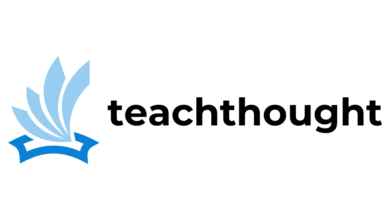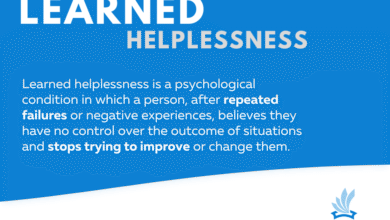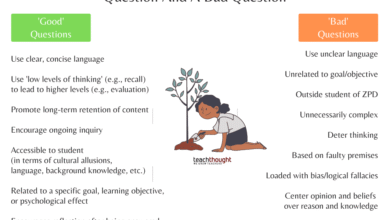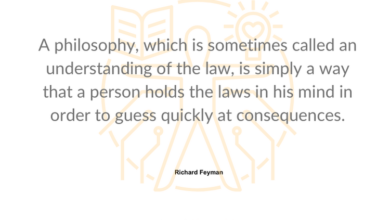Questioning In The Classroom: An Updated Guide

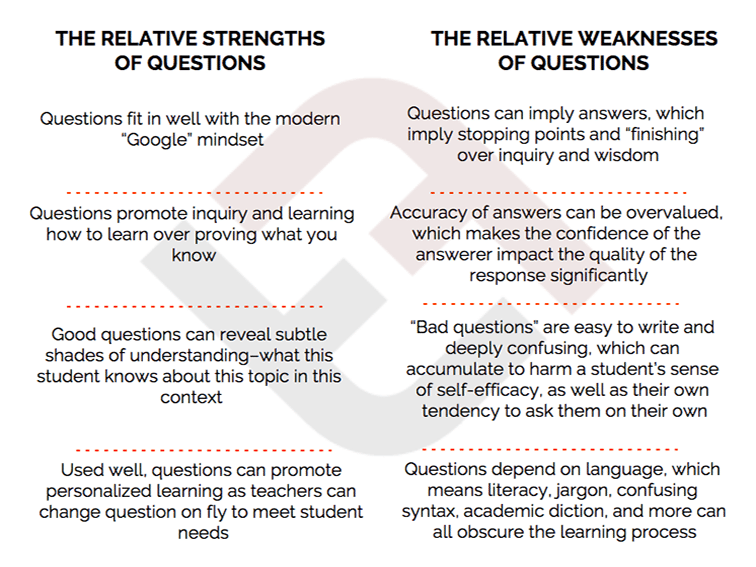

by Terry Heick
If the ultimate goal of education is for students to be able to answer questions effectively, then focusing on content and response strategies makes sense. If the ultimate goal of education is to teach students to think, then focusing on how we can help students ask better questions themselves might make sense, no?
Why Questions Are More Important Than Answers
The ability to ask the right question at the right time is a powerful indicator of authentic understanding. Asking a question that pierces the veil in any given situation is itself an artifact of the critical thinking teachers so desperately seek in students, if for no other reason than it shows what the student knows, and then implies the desire to know more.
Asking a question (using strategies to help students ask better questions, for example) is a sign of understanding, not ignorance; it requires both knowledge and then–critically–the ability to see what else you’re missing.
Questions are more important than answers because they reflect understanding and curiosity in equal portions. To ask a question is to see both backward and forward–to make sense of a thing and what you know about it, and then extend outward in space and time to imagine what else can be known, or what others might know. To ask a great question is to see the conceptual ecology of the thing.
In a classroom, a student can see a drop of water, a literary device, a historical figure, or a math theorem, but these are just worthless fragments. A student in biology studying a drop of water must see the water as infinitely plural–as something that holds life and something that gives life.
As a marker of life, and an icon of health.
It is a tool, a miracle, a symbol, and a matter of science.
They must know what’s potentially inside a drop of water and how to find out what’s actually inside that drop of water.
They must know what others have found studying water and what that drop of water means within and beyond the field of science.
They must know that water is never really just water.
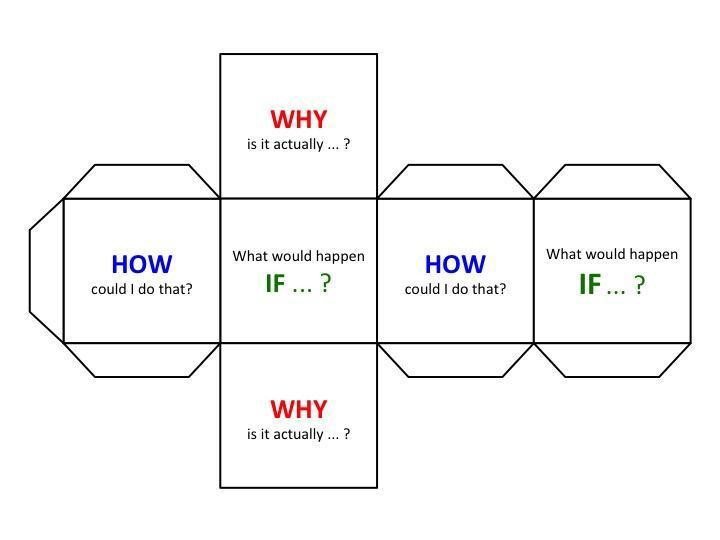

Teacher Questions vs Student Questions
When teachers try to untangle this cognitive mess, they sacrifice personalization for efficiency. There are too many students, and too much content to cover, so they cut to the chase.
Which means then tend towards the universal over the individual–broad, sweeping questions intermingling with sharper, more concise questions that hopefully shed some light and cause some curiosity. In a class of 30 with an aggressively-paced curriculum map and the expectation that every student master the content regardless of background knowledge, literacy level, or interest in the material, this is the best most teachers can do.
This only a bottleneck, though, when the teacher asks the questions. When the student asks the question, the pattern is reversed. The individual student has little regard for the class’s welfare, especially when forming questions. They’re on the clock to say something, anything. Which is great, because questions–when they’re authentic–are automatically personal because they came up with them. They’re not tricks or guess-what-the-teacher’s-thinking.
A student couldn’t possibly capture the scale of confusion or curiosity of 30 other people; instead, they survey their thinking, spot both gaps and fascinations and form a question. This is the spring-loading of a Venus flytrap. The topic crawls around in the student’s mind innocently enough, and when the time is right—and the student is confident—the flower snaps shut. Once a student starts asking questions, that magic of learning can begin.
And the best part for a teacher? Questions reveal far more than answers ever might.
The Purpose of Questions
Thought of roughly as a kind of spectrum, four purposes of questions might stand out, from more “traditional” to more “progressive.”
In What Is The Purpose Of A Question? Terry Heick said:
“To be a little more abstract, a good question causes thinking–more questions. Better questions. It clarifies and reveals. It causes hope.
A bad question stops thinking. It confuses and obscures. It causes doubt.”
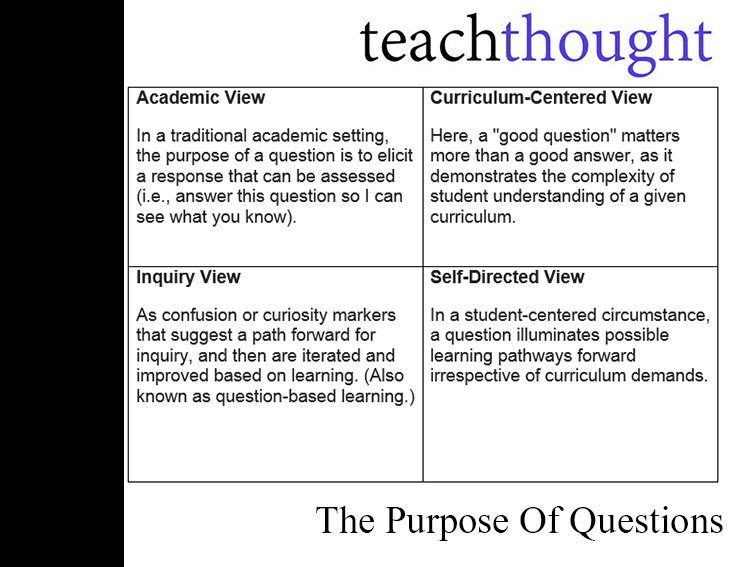

(More Traditional) Academic View
In a traditional academic setting, the purpose of a question is to elicit a response that can be assessed (i.e., answer this question so I can see what you know).
(Less Traditional) Curriculum-Centered View
Here, a ‘good question’ matters more than a good answer, as it demonstrates the complexity of student understanding of a given curriculum.
(More Progressive) Inquiry View
As confusion or curiosity markers that suggest a path forward for inquiry, and then are iterated and improved based on learning. (Also known as question-based learning.)
(More Progressive Still) Self-Directed View
In a student-centered circumstance, a question illuminates possible learning pathways forward irrespective of curriculum demands. The student’s own knowledge demands–and their uncovering–center and catalyze the learning experience.
To be a little more abstract, a good question causes thinking–more questions. Better questions. It clarifies and reveals. It causes hope. A bad question stops thinking. It confuses and obscures. It causes doubt.
The Relative Strengths of Questions
- Good questions can reveal subtle shades of understanding–what this student knows about this topic in this context
- Questions promote inquiry and learning how to learn over proving what you know
- Questions fit in well with the modern “Google” mindset
- Used well, questions can promote personalized learning as teachers can change questions on the fly to meet student needs
The Relative Weaknesses of Questions
- Questions depend on language, which means literacy, jargon, confusing syntax, academic diction, and more can all obscure the learning process
- Questions can imply answers, which imply stopping points and ‘finishing’ over inquiry and wisdom (See questions that promote inquiry-based learning.)
- Accuracy of answers can be overvalued, which makes the confidence of the answerer impact the quality of the response significantly
- “Bad questions” are easy to write and deeply confusing, which can accumulate to harm a student’s sense of self-efficacy, as well as their tendency to ask them on their own
7 Common Written Assessment Question Forms
Questions as written assessment (as opposed to questions as inquiry, questions to guide self-directed learning, or questions to demonstrate understanding) most commonly take the following forms in writing:
Matching
True/False
Multiple Choice
Short Answer
Diagramming
Essay
Open-Ended
Questioning In The Classroom & Self-Directed Learning
For years, questions have guided teachers in the design of units and lessons in classrooms, often through the development of essential questions that all students should be able to reasonably respond to and that can guide their learning of existing and pre-mapped content.
In the TeachThought Self-Directed Learning Model, learners are required to create their own curriculum through a series of questions that emphasize self-knowledge, citizenship, and communal and human interdependence. In this model, existing questions act as a template to uncover potential learning pathways.
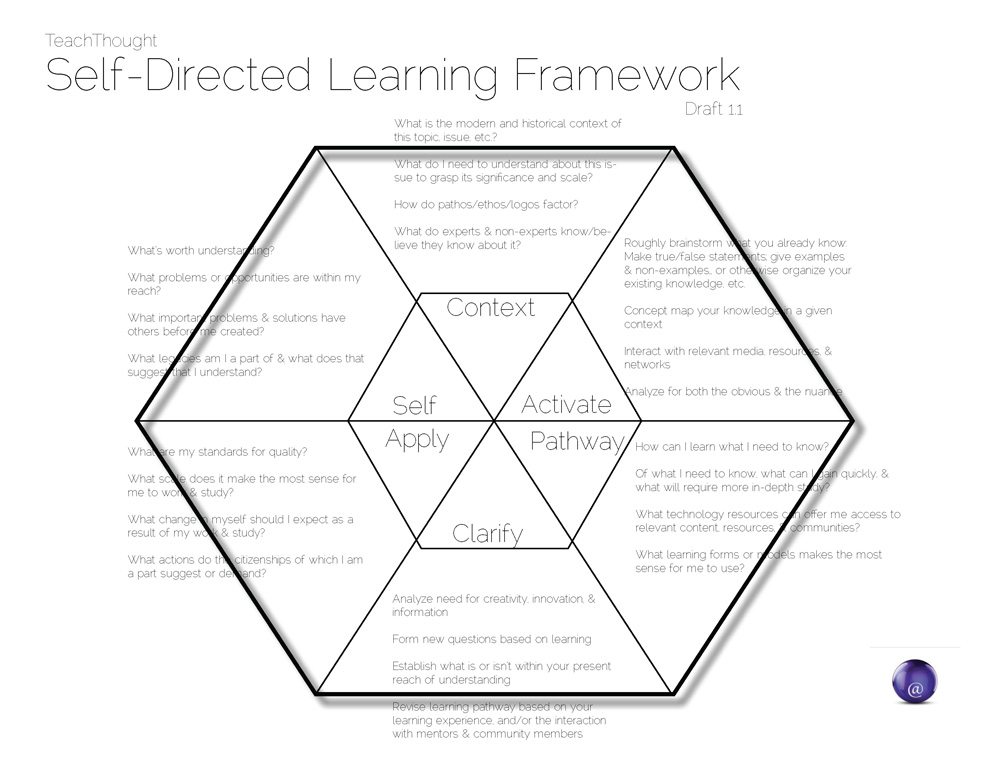

Also, the Question Formation Technique is a powerful strategy for asking questions in the classroom, which you can read about here along with other strategies for helping students ask great questions in the classroom.
What Is Cognitive Dissonance?
Cognitive Dissonance is the cognitively-uncomfortable act of holding two seemingly competing beliefs simultaneously. If you believe that Freedom of Speech is the foundation of democracy, but then are presented with a perspective (through Socratic-style questioning in the classroom from the teacher, for example), you arrive (or the student does) at a crossroads where they have to adjust something–either their belief or their judgment about the validity of the question itself.
In this way, questions can promote Cognitive Dissonance, meaning a good question can change a student’s mind, beliefs, or tendency to examine their own beliefs. Questions, cognitive, and self-reflection go hand-in-hand.
The Role of ‘Lower-Level’ Questions in the Classroom
Lower-level questions inquire at ‘lower levels’ of various learning taxonomies.
These are often ‘recall’ questions that are based in fact—definitions, dates, names, biographical details, etc. Education is thought to have focused (without having been there, who knows for sure?) on these lower levels, and ‘low’ is bad in academics, right? ‘Lower-level’ thinking implies a lack of ‘higher-level’ thinking, so instead of analyzing, interpreting, evaluating, and creating, students are defining, recalling, and memorizing, the former of which make for artists and designers and innovators, and the latter of which make for factory workers.
And that part, at least, is (mostly) true. Recall and memorization aren’t the stuff of understanding, much less creativity and wisdom, except that they are. Bloom’s Taxonomy was not created to segregate ‘good thinking’ from ‘bad thinking.’ In their words, “Our attempt to arrange educational behaviors from simple to complex was based on the idea that a particular simple behavior may become integrated with other equally simple behaviors to form a more complex behavior.” In this way, the taxonomy is simply one way of separating the strands of thinking like different colored yarn–a kind of visual scheme to see the pattern, contrasts, and even sequence of cognitive actions.
Nowhere does it say that definitions, names, labels, and categories are bad–and if it did, we’d have to wonder about the taxonomy rather than assuming that they were. It doesn’t take much imagination to see that if a student doesn’t know there was a war, and that it was fought in the United States in the 1800s, and that it was purportedly over states’ rights, and that both culture, industry, and agriculture all impacted the hows, whens, and whys of the war, that ‘higher-level thinking strategies’ aren’t going to be very useful.
In short, lower-level questions can illuminate and establish foundational knowledge to build a more complex and nuanced understanding of content. They provide a foothold for thinking. To further the point, in 5 Common Misconceptions About Bloom’s Taxonomy, Grant Wiggins explains that the phrases ‘higher-order’ and ‘lower-order’ don’t appear anywhere in the taxonomy.
Essential Questions in the Classroom
Grant Wiggins defined an essential question as “broad in scope and timeless by nature. They are perpetually arguable.”
Examples of Essential Questions
What is justice?
Is art a matter of taste or principles?
How far should we tamper with our biology and chemistry?
Is science compatible with religion?
Is an author’s view privileged in determining the meaning of a text?
A question is essential when it:
causes genuine and relevant inquiry into the big ideas and core content;
provokes deep thought, lively discussion, sustained inquiry, and new understanding as well as more questions;
requires students to consider alternatives, weigh evidence, support their ideas, and justify their answers;
stimulates vital, ongoing rethinking of big ideas, assumptions, and prior lessons;
sparks meaningful connections with prior learning and personal experiences;
naturally recurs, creating opportunities for transfer to other situations and subjects.
You can see more examples of essential questions here.
Bonus
9. Think-Pair-Share
Think-Pair-Share is a collaborative learning strategy that promotes discussion and allows students to share their thoughts and questions with a partner before sharing with the larger group.
Process
Think: Pose a thought-provoking question or problem related to the lesson. Give students a few minutes to think about their responses individually.
Pair: Have students pair with a partner to discuss their thoughts and questions. Encourage them to come up with additional questions during their discussion.
Share: Pairs share their questions and ideas with the class. This can be done by having each pair present their most interesting question or facilitating a larger group discussion where pairs contribute to a growing list of questions.
Follow-Up: Use the questions generated from the Think-Pair-Share activity to guide further inquiry, research projects, or class discussions.
10. Wonderwall
Description: A Wonder Wall is a dedicated space in the classroom where students can post questions that come to mind during lessons, discussions, or independent activities. It is a visual and interactive tool to foster a culture of inquiry.
Process
Create the Space: Designate a section of a wall or a bulletin board as the Wonder Wall. Provide sticky notes, markers, and a way for students to add questions easily.
Introduce the Concept: Explain to students that the Wonder Wall is a place for them to post any questions about the topics being studied or other related curiosities. Encourage them to write their questions on sticky notes and place them on the wall.
Regularly Review and Address Questions: Set aside time each week to review the questions on the Wonder Wall. Select a few questions to investigate further as a class or to incorporate into future lessons and activities.
Encourage Peer Interaction: Allow students to read and respond to their peers’ questions on the Wonder Wall. They can add comments, suggestions, or additional questions, creating a collaborative and dynamic learning environment.
Integrate into Curriculum: Use the questions from the Wonder Wall to guide inquiry-based projects, research assignments, or class discussions. This ensures that student curiosity directly influences learning and keeps students engaged.
A Guide To Questioning In The Classroom; image attribution flickr user flickeringbrad
Source link

